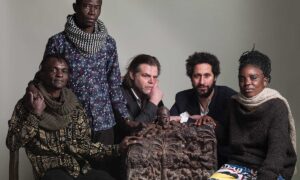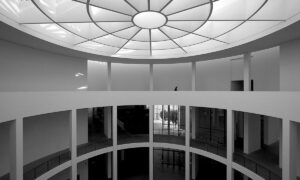
Anselm Kiefer, the German-born, France-based master of the mythical and the grandiose has been bringing his brand of monumental art to audiences worldwide over the past half century. The artist is known for questioning Germany’s post-war identity, drawing on a range of cultural, literary and philosophical sources in a wide variety of media, from paintings and photographs to sculptures and installations. In 1992, having left Germany, Kiefer acquired La Ribaute, an old silk factory in Barjac, southern France. The site developed organically into a vast studio complex comprising pavilions, outdoor art installations, subterranean chambers and a five-level concrete amphitheatre (the complex has been likened to a human ant hill). The artist lived at the 40-hectare site, 70km north-west of Avignon, until 2007, when he relocated to a new studio space in Croissy-Beaubourg on the outskirts of Paris.Kiefer continues to make his mark through permanent works and monuments, especially in France. In 2007 the artist unveiled a 10m-high commission, Athanor, on the walls of the Musée du Louvre’s Egyptian gallery. In 2020, Kiefer unveiled another permanent work at the Pantheon in Paris to mark the arrival of the French writer Maurice Genevoix’s coffin. The artist’s latest exhibition, Fallen Angels, opening at Palazzo Strozzi in Florence on 22 March, typically unpicks epic themes linked to religion, history and literature, prompting visitors to reconsider “our relationship between the spiritual and the material”, according to the organisers.Rise and fall: a still from the Wim Wenders film Anselm (2023) showing Kiefer’s installation Die Himmelspaläste (Heaven’s Palaces, 2003–18), a series of rickety towers made from the stacked concrete casts of shipping containersCourtesy Sideshow and Janus FilmsThe Art Newspaper: The first monumental piece visitors will encounter at your Palazzo Strozzi exhibition is Angel’s Fall (2022-23), a huge painting in the courtyard that depicts the passage from the Book of Revelation describing the battle between the archangel Michael and the rebel angels.Anselm Kiefer: This is something that I was always interested in because it says something about the state of the world. It’s a bird. It’s so imperfect. Life is so badly constructed—we have wars since the beginning, and it will not end. And there is theodicy [the religious and philosophical argument about the existence of evil and an omnipotent god], literally the justification of God, which proves that the world is good because God is good. God is good, but the world is not good. Gottfried Leibnitz [the 17th-century German philosopher] once said that the [real] world is the best of all [imagined] worlds but when the earthquake happened in Lisbon [in 1755], he changed his philosophy. The Christian religion says God is the best you can imagine; he knows all, he decides all. There’s a big contradiction in this.I think the ideas of the Futurists [were] not bad. But the results? I would repaint them allAre you concerned about the state of the world and humanity?At the moment, I’m more concerned than before because the world has become more complex. We had, in the 1970s and 1980s, two worlds—the West and the East. Then it seemed to be easier. It was clear. Before, the border was clear. But even then, it was life-threatening. I know about three situations where the nuclear atomic bomb exploded, not in a war, but by mistake.The idea of the fallen angel, the rebellious angel plummeting into the abyss, continues in the painting Lucifer (2022-23), which will go on show in room one of the exhibition.Yes, Lucifer is the other partner of God who works against God and is at the end defeated by Saint Michael. Then, later in the show, there are the Irradiated Paintings [1983-2023], which are destroyed by me through [the process of] irradiation.These paintings, some of which have been created by submerging the pieces in baths of electrolysis, have been a key part of your practice for decades. More than 60 of them will fill the walls and ceiling of one of the largest rooms in Palazzo Strozzi.Yes, they are a reflection of the world, as opposites of good and bad. They are destroyed by me, because I cannot make a chef-d’oeuvre [a masterpiece].You mean you think that you’ve never created a masterpiece?No. I try all the time, but I can’t, my talent is not enough. I never think a painting can be finished. It’s never finished, in my case. I have so many paintings. If you come to [the studio in] Paris, you would see all the long row of containers housing works from the late 1960s until now.You will be displaying the Heroic Symbols photographs (1969) in the Florence exhibition, which show you replicating the Sieg Heil salute with your arm raised, reflecting how you confront German history. I am fascinated why you think it is important to put the photographs back on public display.If I have to give a biography of my work, it starts here. It’s more an example of my working [practice]. I wouldn’t do it 1710565524 because when I did this, it was at the end of 1960s; then nobody in Germany spoke about [the war], you know? But now you can see every day on the television in Germany something about this time. So nobody can say they are involved anymore; they’re all involved now.In 2014, the BBC programme Imagine said that you “prod incessantly at the open wound of German history”. Do you think all art is inherently political?It’s an open wound. It’s clear. It’s still present. You have in Germany now some politicians who also go back to this time. An artist is, as I am, involved in the situation of the time. I read the newspapers, and I am well informed. So automatically I am political.On a possible political note, in a 2022 discussion with Michael Govan, the director of the Los Angeles County Museum of Art, you said: “Borders are the most boring thing in the world.”You need borders as a human being otherwise you cannot exist. We give [borders and shapes] to the stars, we give them symbols and borders. Borders are completely flexible. The water [sea levels] will go up; I don’t know how many metres they will go up. There will be enormous migration in the future. We should be prepared now. Nobody speaks about that.The documentary film Anselm (2023), directed by Wim Wenders and shot in your studio in Croissy-Beaubourg and at your vast La Ribaute complex, shows you working and moving around the spaces. Your physicality—the way you are burning the paintings with a flamethrower, so they catch fire, and then extinguishing them—is hypnotic.I’m dancing in my studio. I’m dancing in front of my paintings. You know what Friedrich Nietzsche said? He said: “My philosophy is dancing.” It’s part of the physicality. He said this because he was not very physical, he was ill. He always dreamed, dancing [and devising] his philosophy. The hay burns in my paintings but the paintings burn too sometimes. There’s someone behind who cools down the canvas, but the colours, they burn.And La Ribaute is your version of a museum?It’s not a museum at all. I still work there. It’s like a painting: I started and I continue, and I add [things]. It’s now a foundation [Eschaton—Anselm Kiefer Foundation], and so when I die, it stays there. It doesn’t get dispersed in all directions because it’s untouchable, which is good.It will be your memorial?You’ve given me the idea. Perhaps I have to ask the mayor, can I get buried there? Death is not morbid; I think every day about my death. It’s part of life. Without death, you wouldn’t have this life.Does fame—or notoriety—interest you?I have two parts. On one side, I’m ambitious, but I think the ambition to be famous is very naive. I can tell you about many painters who were famous when they died, and nobody knows them now today. So this kind of fame is relative. In the 1980s I became a kind of star. But I was not aware of this. I was always just concerned about my work. When I arrived in New York [in the 1980s] at immigration, two ladies came and took me aside [for a fast-tracked immigration process]. So I thought: “Yes, this is perhaps fame.”But you have a certain licence and privilege. Not every artist can take over the Palazzo Ducale in Venice as you did in your 2022 blockbuster show.Certainly not. There are other [notable] artists. Vija Celmins—she wouldn’t do Doge’s Palace, but she’s good. She does these little things, these little points, the sea and the stars.It follows that most people would say you are a monumental artist.It’s nonsense. My favourite painter, who did the Havana paintings [in the late 1950s], is Willem de Kooning. His Havana paintings are, I think, 80in by 70in, and they are monumental. Monumentality is not a sign of dimensions. It’s a sign of character of the painting. A small painting can be monumental. The scale is completely unimportant.You soak up and cite multiple figures who have influenced you, including Jean Genet, Martin Heidegger and the Romanian poet Paul Celan. In the Palazzo Strozzi show, the work The Solitary Place (2019-23) draws on the Surrealism of Raymond Roussel.I have a library. And in the morning before I start, I go through my library. I take out a book and read it, so I’m always together with a lot of other people from other centuries. They are my critics.What about the “isms” of art history? Futurism, for example, is still underrated.I think the ideas of the Futurists, the theory, the idea, was not bad. But the results? I would repaint them all. I would like to have them in my studio. I would make something out of them.Anselm Kiefer’s Angel’s Fall (2022-23) depicts the battle between good and rebel angels that ends with the fall of LuciferPhoto: Georges Poncet © Anselm Kiefer BiographyBorn 1945 Donaueschingen, GermanyLives and works Paris, FranceEducation 1966-69 State Academy of Fine Arts, Karlsruhe and FreiburgKey shows 1980 West German pavilion, 39th Venice Biennale; 1988 Museum of Modern Art, New York; 2001 Louisiana Museum of Modern Art, Humlebaek; 2007 Monumenta, Grand Palais, Paris; 2014 Royal Academy of Arts, London; 2015 Centre Pompidou, Paris; 2022 Palazzo Ducale, VeniceRepresented by Gagosian, White Cube, Thaddaeus Ropac and Lia Rumma GalleryAnselm Kiefer: Fallen Angels, Palazzo Strozzi, Florence, 22 March-21 July
























